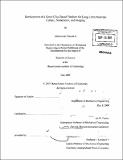Development of a novel chip-based platform for long-term neuronal culture, stimulation, and imaging
Author(s)
Vincent, John Gerald, II
DownloadFull printable version (5.023Mb)
Other Contributors
Massachusetts Institute of Technology. Dept. of Mechanical Engineering.
Advisor
Ian W. Hunter.
Terms of use
Metadata
Show full item recordAbstract
The flame plasma treatment studied in this thesis was able to oxidize the surface of Polydimethylsiloxane (PDMS) in a fraction of a second. It was found to be a much faster way to modify PDMS surface wettability than the current technologies. The surface wettability of Polydimethylsiloxane (PDMS) treated with flame plasma was studied. The surface wettability was characterized by contact angle measurements using water and a surface tension liquid as the probe liquids. Two experimental parameters were varied in this investigation: a) distance from the PDMS surface to the inner flame cone; b) the dwell time of the PDMS under the flame. The study concluded that the same surface wettability can be achieved through different ombinations of distance and dwell time. The shortest dwell time needed to induce a contact angle of 100 or less on the treated PDMS surface in this experimental setup was approximately 0.18 second. This study also found that over treatment of the PDMS surface in the flame plasma yielded a reversal treatment effect and decreased the surface wettability. The flame plasma yielded uniform contact angle measurements within 15% across the PDMS surface. The recovery High-throughput cell-based screening has recently been emerging as a feasible technology for drug testing and discovery. However, currently available tools for electrical assaying are expensive, have limited reproducibility, and are unable to sustain long term studies. The Bioinstrumentation Laboratory at the Massachusetts Institute of Technology has developed a novel, 3D MEA for use in long term study of neuronal cells. These arrays will be cheap and disposable, allowing integration into a fixed stimulation and imaging setup. Neuronal cell activity will be monitored using a Ca2+ sensitive dye that can be visualized via the imaging setup. In the past year, the ioinstrumentation Laboratory has worked to refine the parameters required to generate replicable, conductive, biocompatible columnar polypyrrole posts using a polydimethylsiloxane mask. In addition, these posts have been shown to support neuronal cell growth. However, proof of concept requires that the neurons growing on these disposable arrays be able to be selectively stimulated via a raphical interface. The work presented in this thesis describes the development of this interface in a LabVIEW environment. The interface uses the channels of a data acquisition board to individually control the electrodes comprising the MEA. Unlike currently available electrode stimulators, ours allows for the selection of multiple electrodes, rather than just one or two, and a user selected patterning firing sequence. The proposed design was demonstrated using an array of LEDs setup on a bread board. In addition to the development of an electrode stimulator, reliability testing of the electrical contact between the posts and electrodes on a commercially available MEA was tested by seating the array on top ofmechanism in the treated PDMS surfaces was dominated by the diffusion of untreated polymers from the bulk PDMS to the treated surface. The results from this investigation demonstrated the potential for the flame plasma treatment to be used in rapid manufacturing of PDMS microfludic devices. the MEA. However, to receive better results, the laboratory will plasma treat the surfaces to allow better contact between the surfaces.
Description
Thesis (S.B.)--Massachusetts Institute of Technology, Dept. of Mechanical Engineering, 2009. Cataloged from PDF version of thesis. Includes bibliographical references (p. 24).
Date issued
2009Department
Massachusetts Institute of Technology. Department of Mechanical EngineeringPublisher
Massachusetts Institute of Technology
Keywords
Mechanical Engineering.